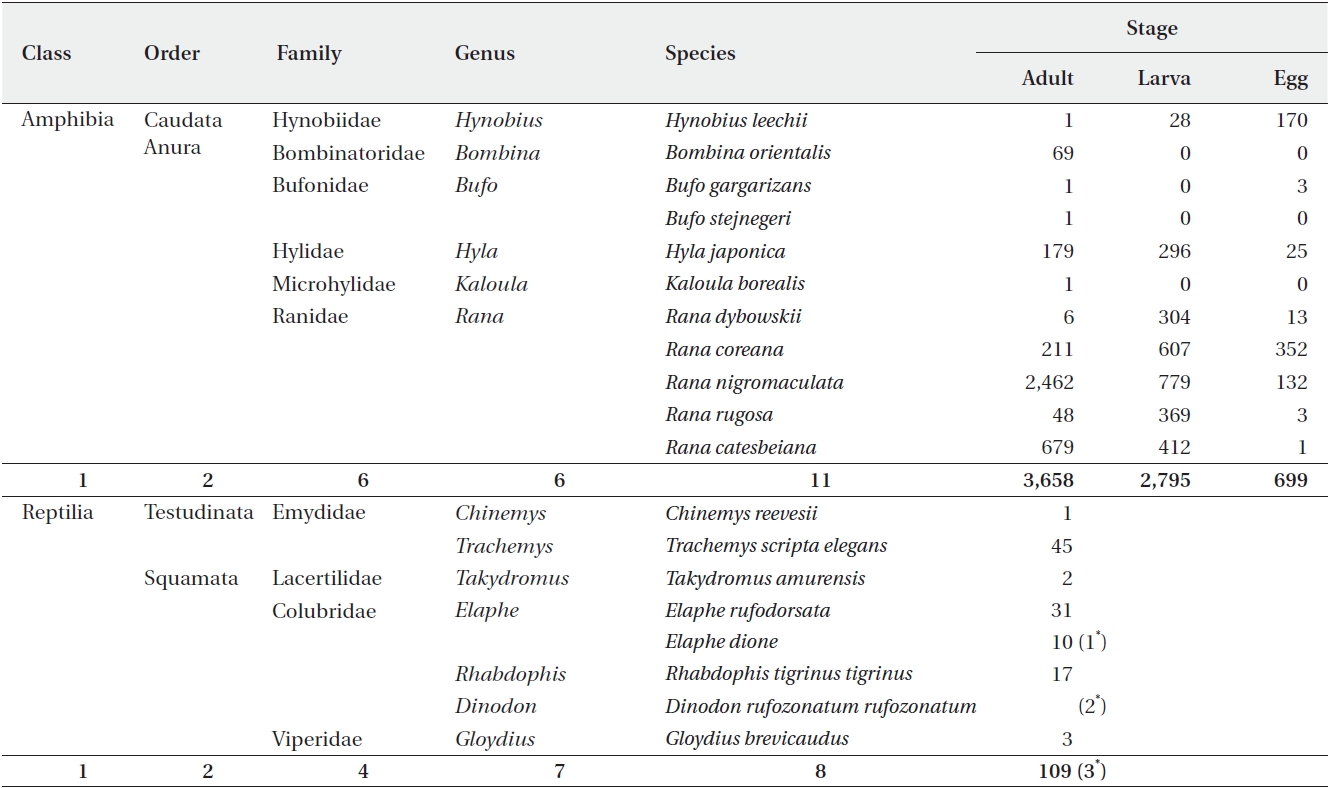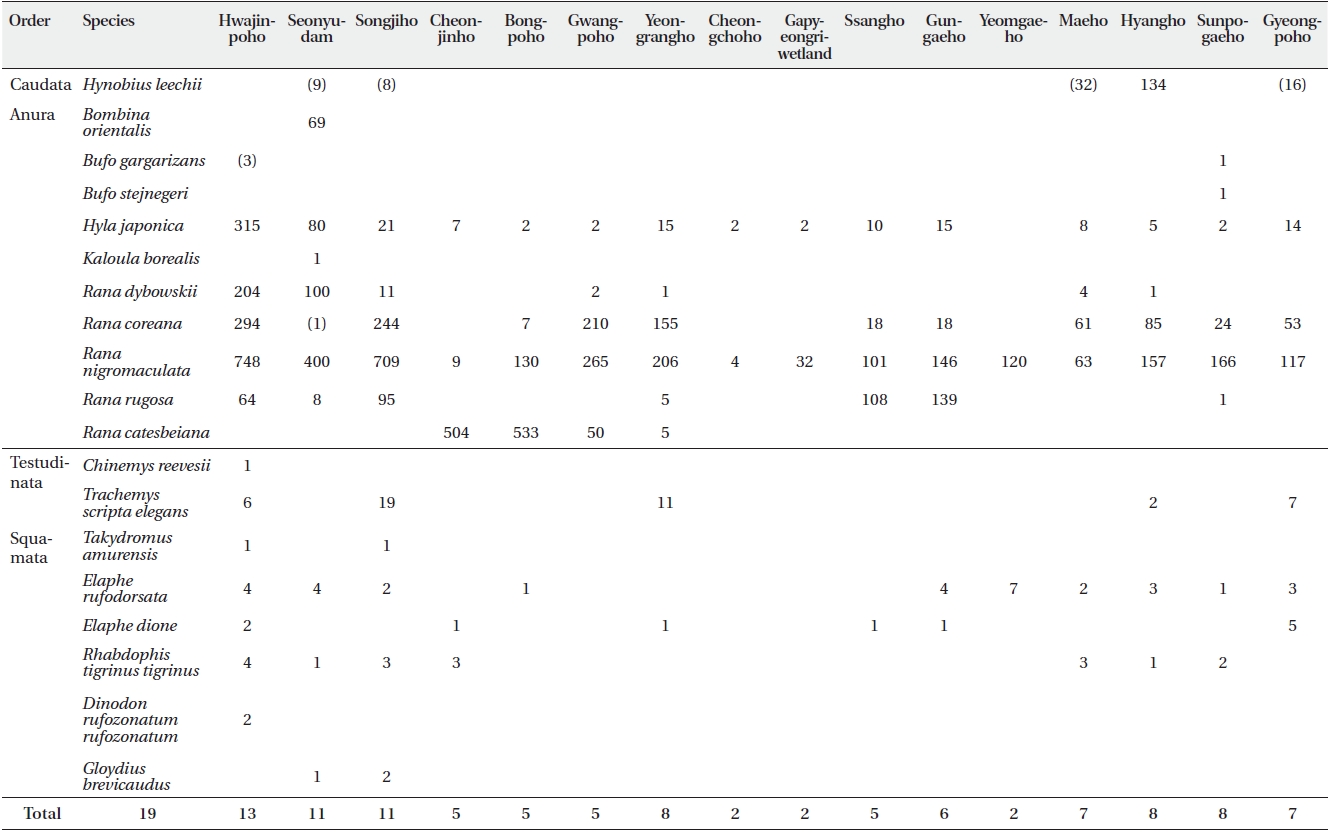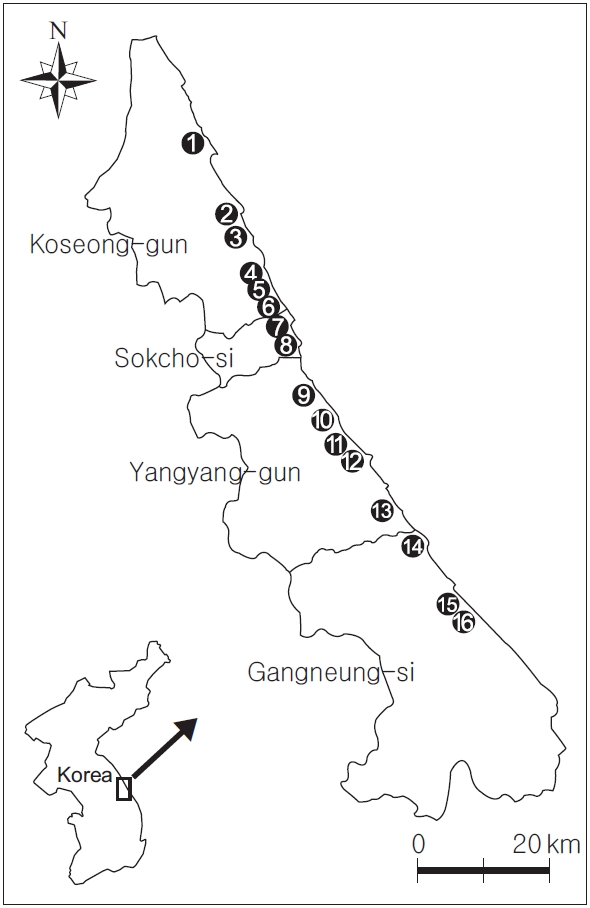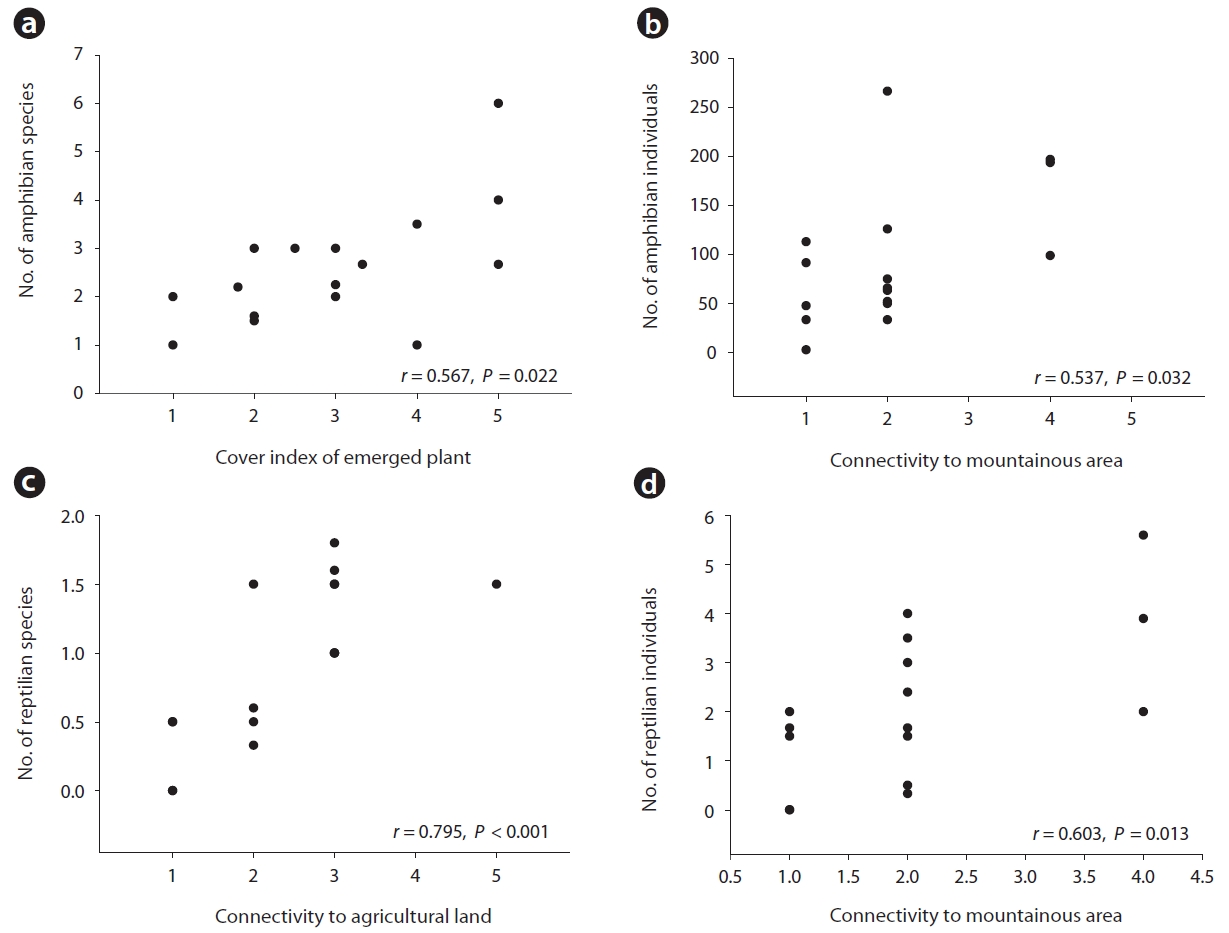



Lagoons are a type of coastal wetland formed by the combined action of rivers or streams and the ocean (Heo et al. 1999, Hwang and Yoon 2008). Lagoons perform a crucial function in local ecosystems, as both brackish lakes and natural wetlands (Um 1998). In South Korea, 18 lagoons were reported along the eastern coastline in Gangwon-do: seven lagoons in Koseong-gun (Hwajinpoho, Seonyudam, Songjiho, Cheonjinho, Bongpoho, Bongpo-wetland, Gwangpoho), two lagoons in Sokcho-si (Yeongrangho, Cheongchoho), five lagoons in Yangyang-gun (Gapyeongri-wetland, Ssangho, Gungaeho, Yeomgaeho, Maeho), and four lagoons in Gangneung-si (Hyangho, Sunpogaeho, Gyeongpoho, Poongho) (Heo 2009). These lagoons have been disrupted by human activities such as the expansion of agricultural areas, partial modification into recreational parks, and sewage dumping, as well as by natural processes including the accumulation of organic materials and deposits. These lagoons have lost their original topographic shapes and ecological functions in local ecosystems (Um 1998, Kim et al. 2001).
In order to successfully preserve or restore the health of lagoon ecosystems, it is first necessary to understand the local organisms and their habitat requirements (Pough et al. 2004). Recent studies have demonstrated that the systematic connections between wetlands and nearby small wetlands, grasslands, and terrestrial areas are critical for healthy wetland ecosystems (Semlitsch and Bodie 2003). Amphibians and reptiles utilize water bodies and terrestrial areas throughout their lives, and play a key role in linking aquatic and terrestrial ecosystems. In South Korea, studies of lagoon ecosystems have been conducted primarily for relatively large lagoons such as Yeongrangho, Cheongchoho, and Gyeongpoho (Heo et al. 1999), and the majority of studies have focused on water quality, plankton populations, and species lists of birds and fishes (Yang 2003). To date, very few studies concerning the herpetofauna of Korean lagoon ecosystems have been conducted (Kim 1997, Shim 2001, Lee and Song 2002a, 2002b). In this study, we identified the amphibian and reptilian species occurring in 16 lagoons along the eastern coastline of South Korea over two years of field surveys, and we investigated the habitat characteristics that affected the number of amphibian and reptilian species as well as the number of individuals of them in these lagoon ecosystems.
This is an Open Access article distributed under the terms of the Creative Commons Attribution Non-Commercial License (http://creativecommons. org/licenses/by-nc/3.0/) which permits unrestricted non-commercial use, distribution, and reproduction in any medium, provided the original work is properly cited.
We surveyed the herpetofauna and habitat characteristics of 16 lagoons, four times per year in 2007 (29-30 Mar, 29-31 May, 3-4 Jul, 13-14 Sep) and 2008 (18-19 Apr, 15-16 May, 17-19 Jul, 18-19 Sep) (Fig. 1). We excluded two eastern coastline lagoons (Bongpo-wetland and Poongho) from the study, due to the lack of any water bodies for anthropogenic disruptions. Prior to conducting the field surveys, we arbitrarily classified the 16 lagoons into three size groups on the basis of the maximum diameter of each lagoon (derived from a 1:25,000-scale map: ≤ 0.2 km, between 0.21 and 1.0 km, and ≥ 1.1 km). For the lagoons in each group, we designated two (Cheongchoho, Seonyudam, Cheonjinho, Ssangho, Yeomgaeho, Sunpogaeho), three (Gwangpoho, Maeho, Bongpoho, Gungaeho), or five (Hwajinpoho, Songjiho, Yeongrangho, Hyangho, Gyeongpoho) detailed survey sites, respectively. Each survey site was composed of appropriate habitats such as small wetlands, paddy fields, ponds, or streams (for amphibians), and agricultural land or mountains (for reptiles) located within 30-50 m of the lagoon edge.
Two persons with more than four years of experience in field surveys of amphibians and reptiles surveyed each detailed survey site while walking slowly along the boundary of a lagoon for 15 minutes (about 300 m × 20 m). Upon encountering any amphibians or reptiles, we immediately identified and classified the animals based on the criteria established by Park et al. (2006), Song (2007), and Kim (2009), and recorded the classification in our field notes. Using a stopwatch, we excluded the time required to record the data from the 15-min survey time. We also surveyed juveniles of amphibians at each survey site using a deep net (0.8 m length × 0.6 m wide, 5 mm mesh) for three trials.
To determine the characteristics of amphibian and reptile habitats in lagoons, we measured 14 factors at each detailed survey site: pH; dissolved oxygen (DO); cover indices of submerged plant and emerged plant; number of birds; number of insect orders; distances from the lagoon edge to the nearest road, residential area, and mountain; connectivity to agricultural land and mountainous area; salinity; lagoon size; and lagoon perimeter length. We measured pH and DO from 200 mL of water collected from 1 m inside the lagoon edge, using a pH meter (EcoScan; Eutech, Ayer Rajah Crescent, Singapore) and a DO meter (DO-5Z; KRK, Kuki, Japan). The cover indices of submerged plant and emerged plant were estimated by two people on a scale of one to five: 0%, 1-25%, 26-50%, 51-75%, and 76-100%. To determine the number of birds, we only counted large birds belonging to the families Phalacrocoracidae, Ardeidae, and Anatidae, which were either inside the lagoons or within 30 m of the lagoon edge. To determine the number of insect orders, we captured insects at each survey site using an insect net (0.5 mm mesh), five times at each location. The captured insects were then transported to the laboratory in cooling box (< 10℃) and frozen at -20℃. The insects were classified up to the order level based on the criteria established by Kim (2005). The cover indices of both submerged plant and emerged plant, number of birds, and number of insect orders were measured exclusively in 2007. The distances from the lagoon edge to the nearest road, residential area, and mountain were estimated using aerial photographs (Daum map sky view 2009). We defined a road as any paved roadway with two or more lanes, and defined a residential area as an area containing more than five houses. The mountain was composed of shrubs and trees. Connectivity to agricultural land and mountainous area was estimated using aerial photographs on an index (1-5 points): 0%, 1-25%, 26-50%, 51-75%, and 76-100%. The data for salinity, lagoon size, and lagoon perimeter length were extracted from the data reported by Heo (2009).
The number of amphibian and reptilian species was determined as the sum of the species observed at least once during the surveys. To calculate the standardized number of amphibian individuals, we considered each adult, egg mass, tadpole, and single egg as 1, 1, 0.1, and 0.01 individuals, respectively, based on the previous report of Wells (2007). For the reptile individuals, each adult and juvenile was considered as one individual. To compare the number of amphibian and reptilian species and the number of individuals of them with the characteristics of their habitats, we first standardized our data among the lagoons. The calculated number of amphibian and reptilian species and the number of individuals of them at each lagoon were divided by two (two years of surveys), and again by the number of survey sites located in each lagoon. This was also done for the number of birds and insect orders in each lagoon. The pH, DO, and cover indices of submerged plant and emerged plant were averaged across the survey sites in each lagoon. As the majority of the data did not pass the normality test (Kolmogorov-Smirnov, P < 0.05), relationships between the number of amphibian and reptilian species and the number of individuals of them and their habitat characteristics were analyzed via Spearman's correlations (SPSS ver. 16; SPSS Inc., Chicago, IL, USA).
A total of 11 amphibian species in 6 genera, 6 families, and 2 orders, as well as 8 reptile species in 7 genera, 4 families, and 2 orders were detected in the surveys (Table 1). Hwajinpoho harbored the greatest number of amphibian and reptilian species, whereas Cheongchoho, Gapyeongri-wetland, and Yeomgaeho harbored the fewest (Table 2). No reptiles were detected in Gwangpoho, Cheongchoho, and Gapyeongri-wetland.
The dominant amphibian species was the black-spotted pond frog,
The number of amphibian species was correlated positively with the cover index of emerged plant (
[Table 1.] The amphibian and reptilian species confirmed in 16 lagoons during surveys in 2007-2008

The amphibian and reptilian species confirmed in 16 lagoons during surveys in 2007-2008
[Table 2.] Amphibians and reptiles confirmed in each lagoon during the 2007-2008 surveys

Amphibians and reptiles confirmed in each lagoon during the 2007-2008 surveys
The number of reptilian species was positively correlated with connectivity to agricultural land (
Other factors, including DO, number of insect orders, and distance to the nearest residential area were not correlated with either the number of amphibian and reptilian species, or the number of individuals of them (
We documented 11 amphibian and 8 reptilian species. The dominant amphibian was the black-spotted pond frog (
The studies thus far on Korean lagoon herpetofauna have been conducted for several lagoons. Seven of the amphibian species (
The majority of amphibians and reptiles detected in the lagoons are common species that abound in agricultural wetlands, waterways, and low-lying areas (Kang and Yoon 1975, Song 2007).
Invasive species not only compete with endemic species, but also disrupt local ecosystems by functioning as new predators and transmitters of disease (Invasive Species Specialist Group 2000, Lowe et al. 2000, Gurevitch and Padilla 2004). In South Korea, 16 species of animals and plants are currently designated as invasive species, including
Although the route by which the invasive species were introduced to these lagoons is not completely understood,
The number of amphibian species and the number of individuals of them were affected by pH, salinity, emerged plant cover, number of birds, distance to the mountain, connectivity to mountainous area, and lagoon size, whereas the number of reptilian species and individuals were primarily affected by connectivity to the agricultural and mountainous areas, lagoon size, and lagoon perimeter length. Emerged plant cover and connectivity to mountainous area could influence the number of amphibian species and/or individuals by providing potential hiding places and shelters (Raxworthy and Attuquayefio 2000, Martin and MaComb 2003). As the amphibians have a permeable skin (Stebbins and Cohen 1995), higher pH, and salinity, this could negatively affect the number of amphibian species and/or individuals. It has been known that birds, as one of the principal predators of amphibians, frequently forage for amphibian eggs, tadpoles, and frogs (Cushing and Allan 2001, Wells 2007). For example, more than 34% of the total food items of the egrets and herons were identified as amphibians (Jenni 1973, Smith 1997). Therefore, it seems likely that the number of birds in a region could influence the number of amphibian species. With increases in the lagoon size, the number of amphibian species per unit area decreased, thereby implying that the appropriate habitat area might not increase at the same rate as the total lagoon area. Connectivity to agricultural land and mountainous area was associated significantly with the number of reptilian species or individuals, as it was for the amphibians. Such results may be associated with the fact that the reptiles detected in this study, such as
Many recent studies have demonstrated that to conserve biological diversity in wetlands, wetland areas as well as peripheral terrestrial areas should be protected (Bulger et al. 2003, Ra et al. 2008). Terrestrial buffer areas could protect water resources against pollution due to human activities and maintain appropriate water temperatures (Lowrance et al. 1984, Semlitsch and Bodie 2003). Additionally, terrestrial buffer areas provide key habitats such as hibernacula and foraging sites (Raxworthy and Attuquayefio 2000, Fellers and Kleeman 2007). Our results suggest that to conserve the herpetofauna of Korean lagoons, the lagoons themselves as well as the surrounding wetlands, grasslands, and mountains should be protected.



